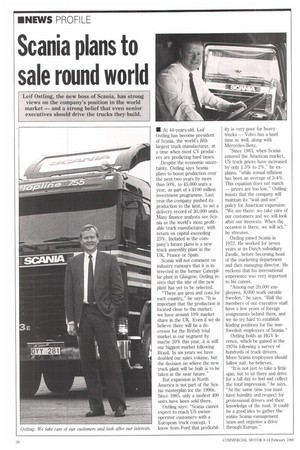Scania plans to sale round world
Page 34

If you've noticed an error in this article please click here to report it so we can fix it.
• At 44-years-old, Leif Ostling has become president of Scania, the world's fifth largest truck manufacturer, at a time when most CV producers are predicting hard times.
Despite the economic uncertainty, Ostling says Scania plans to boost production over the next two years by more than 50%, to 45,000 units a year, as part of a £100 million investment programme. Last year the company pushed its production to the limit, to set a delivery record of 30,000 units. Many finance analysts see Scania as the world's most profitable truck manufacturer, with return on capital exceeding 25%. Included in the company's future plans is a new truck assembly plant in the UK, France or Spain.
Scania will not comment on industry rumours that it is interested in the former Caterpillar plant in Glasgow; Ostling insists that the site of the new plant has yet to be selected.
"There are pros and cons for each country," he says. "It is important that the production is located close to the market; we have around 10% market share in the UK. Even if we do believe there will be a decrease for the British total market in our segment by maybe 20% this year, it is still our biggest market following Brazil. In six years we have doubled our sales volume, but the decision on where the new truck plant will be built is to be taken in the near future."
But expansion in North America is not part of the Scalia masterplan for the 1990s. Since 1985, only a modest 400 units have been sold there.
Ostling says: "Scania cannot expect to reach US owneroperator customers with a European truck concept. I know from Ford that profitabil
ity is very poor for heavy trucks — Volvo has a hard time as well, along with Mercedes-Benz.
"Since 1983, when Scalia entered the American market, US truck prices have increased by only 1.5% to 2%," he explains, "while annual inflation has been an average of 3-4%. This equation does not match — prices are too low." Ostling insists that the company will maintain its "wait-and-see" policy for American expansion: "We are there: we take care of our customers and we will look after our interests. When the occasion is there, we will act," he stresses.
Ostling joined Scania in 1972. He worked for seven years at its Dutch subsidiary Zwolle, before becoming head of the marketing department and then managing director. He reckons that his international experience was very important to his career.
"Among our 20,000 employees, 8,000 work outside Sweden," he says. "Half the members of our executive staff have a few years of foreign assignments behind them, and we do try hard to establish leading positions for the nonSwedish employees of Scania."
Ostling holds an HGV licence, which he gained in the 1970s following a survey of hundreds of truck drivers. More Scania employees should follow suit, he believes.
"It is not just to take a little spin, but to sit there and drive for a full day to feel and collect the total impression," he says. "At the same time you must have humility and respect for professional drivers and their knowledge of the road. It could be a good idea to gather the entire Scania management team and organise a drive through Europe."




















































































































